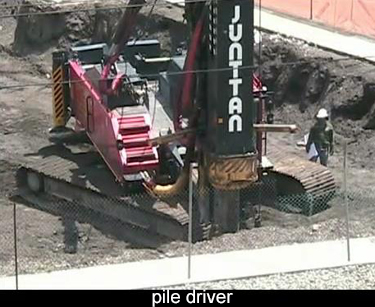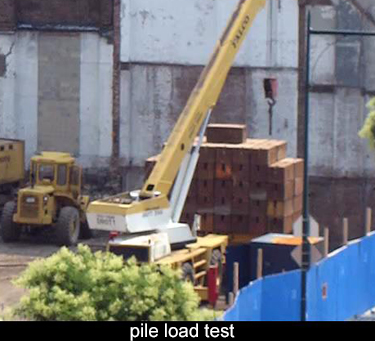I wanted you to have a look at piledriving equipment and just watch the behavior of this pile. It's quite unusual. It passes through a very thick layer of very soft material. You would call that a push. The hammer is not even working, just the weight of the hammer itself is pushing the pile through this soft material. A layer of soft material like that can be a real problem in terms of how these roadways begin to settle over time. Once you add load of this very compressible layer, you can expect some long-term settlement.
Here, the pile is being driven not to refusal. Refusal would mean driving it to rock where it simply won't go any further. But this pile seems to be advancing. Some predetermination has been made as to when it reaches satisfactory resistance. The inspector, who is tracking the progress, is looking for this predetermined amount, and it might be six or eight or ten blows to advance the pile an inch. This has been worked out in advance, and he's just there to verify that the pile is reaching this predetermined amount.
 You can see it's getting very, very close to the ground. and he is counting these last few blows. In another minute, the rig really will not be able to advance the pile any further. We're all waiting to see if this is a good pile or not.
You can see it's getting very, very close to the ground. and he is counting these last few blows. In another minute, the rig really will not be able to advance the pile any further. We're all waiting to see if this is a good pile or not.
 This is a pile load test. You construct a platform of heavily weighted material above the driven pile and you introduce a hydraulic jack between the top of the pile and the dead load that you've created - and you jack against the pile and measure the deflection, or the movement of the pile over time.
This is a pile load test. You construct a platform of heavily weighted material above the driven pile and you introduce a hydraulic jack between the top of the pile and the dead load that you've created - and you jack against the pile and measure the deflection, or the movement of the pile over time.
You plot out all of the results and see from the results whether or not it's behaving the way you want it to, and is developing the capacity that you require for your structure. If it is, then the pile test passes and the criteria that you used for deriving how many blows per inch will be deemed satisfactory. You will have tested it in place and determine that that size hammer driven with that many blows per inch produces the capacity that you're looking for.
If it falls short, you may have to increase the number of blows per inch and try again until you develop a pile, which has the capacity that you want. In this case, the platform of weight looks like it's a series of pig-iron blocks, but it can be concrete blocks. It can be even a precast concrete barriers, whatever material you have available.
Under certain circumstances. you can drive a pile on either side of the test pile and actually jack against the two adjoining piles. The adjoining piles have to have tremendous resistance against uplift, because you don't want to pull them out of the ground before you’ve reached the capacity for your test pile. This is how you test the capacity of a driven pile right on your site and verify that you're using the correct driving criteria.